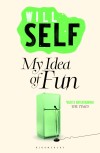Greg Heinimann at Bloomsbury has created a series of new book covers for Will Self’s back catalogue to coincide with the paperback publication of Walking to Hollywood (below) in September. The new covers are for My Idea of Fun, The Quantity Theory of Insanity, Cock & Bull, The Sweet Smell of Psychosis, Junk Mail, Grey Area, Great Apes and The Butt.
Read a short report about it in Creative Review here.


